The purpose of this activity is to support students in applying their knowledge of addition facts to ten by recalling the missing addend in a sum to ten.
- Counters (circular, square or novelty counters)
- Blank Tens Frames
- Masking card (A5 size is good)
Pose missing addend problems with sums to ten by presenting students with 2 tens frames. Place some (e.g. 4) counters on the left frame and conceal the number of counters (e.g. 3) on the right frame. This example is shown below.
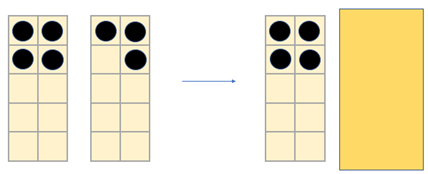
I have four counters (point to the visible frame) and some more counters over here (point to the concealed frame).
Altogether there are seven counters (circling the whole collection).
How many counters are hidden under the card? (Point to the concealed frame)
Students might show you the answer with finger patterns, by writing the answer in ‘invisible ink’ in the air, or by tracing on the ground. Encourage students to answer quickly rather than count on. Close approximations are better than counting on at this stage.- Reveal the second frame. There were 3 counters hidden under the card. Avoid counting the total to verify it
How did you know there were three counters under here?
Look for students to say they knew the missing number or used a deriving strategy with a fact they know, such as, “I know 4 + 2 = 6 so 4 + 3 = 7.”
- Vary the missing addend by keeping the number of counters on one frame the same, and varying the number of counters on the other, masked frame. Explore all addition facts to 10 with your chosen starting number (e.g. from 4 + 0 to 4 + 6).
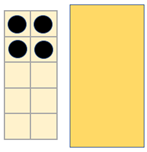
I have four counters and some more counters over here (point to both frames).
Altogether there are nine counters (circling the whole collection).
How many counters are under here?
Look for students to apply their experience of previous problems to figure out the missing addend for new problems. Encourage pattern seeking and trusting fact knowledge, such as “I knew it was five because 4 + 4 = 8.” You might use the counters, or have students use them, to model how 4 + 4 = 8 transforms into 4 + 5 = 9.
- Build up a collection of 4 + __ = ___ problems with missing addends. Record the results and display them as a vertical pattern of addition facts. Leave some spaces in the pattern or write the whole pattern and then rub out or conceal some of the expressions. For example:
4 + 1 = 5
4 + 3 = 7
4 + 4 = 8
4 + 6 = 10
- What facts are missing?
Look for students to use patterns and derive their answers from the expressions still shown.
Erase an increasing amount of the shown facts and ask students to recall the missing expressions from memory.
Four plus what equals nine?
- Provide lots of opportunities for students to explore similar sequences of facts starting with different numbers of counters on the visible frame. Try to avoid introducing sums beyond the range of sums to ten, unless you feel an extension is appropriate for your students. Ensure students have opportunities to express their mathematical thinking in different ways (e.g. online tasks, written, verbal, drawn diagrams, acting out, using physical manipulatives). Te reo Māori kupu such as tāpiri (add) could be used throughout these activities.
Emphasise that you value "knowing" the facts as well as being able to work them out.
For example:
I have two counters and some more counters over here (pointing).
Altogether there are eight counters (circling the whole collection).
How many counters are under here?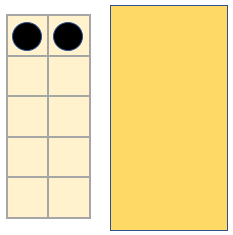
- Progress to situations where you retain the same sum but vary the known number of counters on the left frame.
I have a total of ten counters here (circling the collection). How many counters are hidden?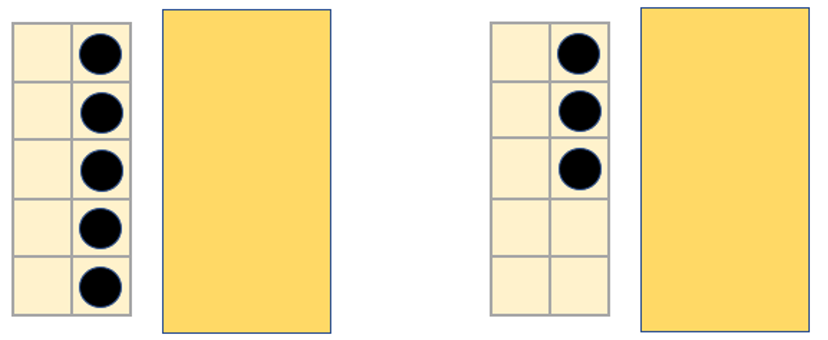
- Record the results and display them as a vertical pattern of addition facts. Leave some spaces in the pattern or write the whole pattern and then rub out or conceal some of the expressions. Gradually erase the equations and ask students to recall missing addends. For example,
Two and what equals ten?
Seven and what equals ten?
Next steps
Patterning supports students to connect the addition facts which aids memory.
- Set up a trusted addend unknown fact using tens frames. For example:
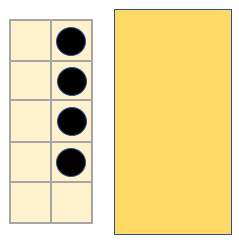
There are eight counters altogether. How many counters are hidden?
Record 4 + __ = 8 and establish that the missing addend is four.
Use the 4 + 4 facts to solve these problems:
4 + __ = 7
4 + __ = 9
3 + __ = 8
5 + __ = 8
The answers students give can be confirmed by adding or subtracting counters from the tens frame model. As much as possible, encourage students to rely on symbols and knowledge, rather than using counters.
Provide lots of opportunity for practice and provide students with a way to monitor their progress in learning the facts.